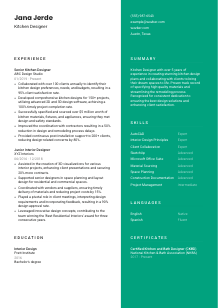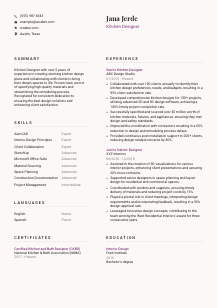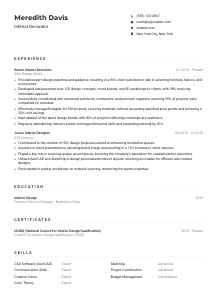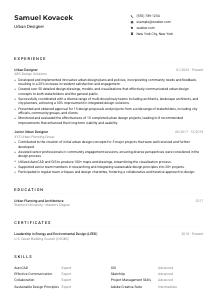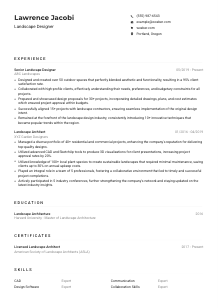Kitchen Designer Resume Example
Crafting culinary visions, but your resume lacks flavor? Delve into this Kitchen Designer resume example, cooked up using Wozber free resume builder. Uncover how you can blend your aesthetic sense with job recipe, making your career as sharp and inviting as a chef's favorite knife!
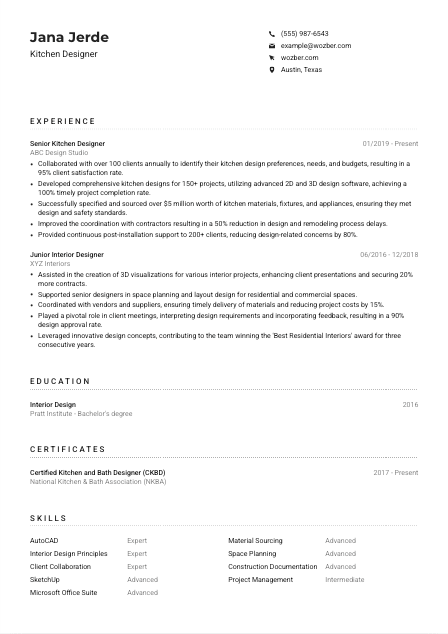
How to write a Kitchen Designer resume?
Hey there, aspiring Kitchen Designer! Bursting into the kitchen design scene requires more than just a passion for aesthetics or a knack for spatial planning. It's about communicating your expertise, experience, and design philosophy effectively through your resume. Crafting a resume that resonates with the essence of kitchen design, aligned perfectly with your dream job's requirements, is your first step toward that coveted position.
With the Wozber free resume builder, this guide will steer you through crafting a resume tailored to a Kitchen Designer position that not only passes the ATS but also stirs the interest of your future employer. Let's cook up a resume that opens doors to your design future!
Personal Details
The opening section of your resume offers a brief introduction to who you are professionally. For a Kitchen Designer role, it's about more than just stating your name; it's your chance to make a memorable first impression. Let's slice into how to customize this section to reflect your readiness for the Kitchen Designer position.
1. Make Your Name Stand Out
Think of your name as the logo of your personal brand. Highlight it in a bold, clear font to ensure it catches the eye. This isn't just a formality—it's the start of your story.
2. Match the Job Title
Right below your name, clearly state "Kitchen Designer." This alignment with the job title immediately signals to hiring managers and ATS that you're a direct match for the position.
3. Keep Contact Information Practical
- Phone Number: Ensure it's your primary contact number. A simple mistake here could mean a missed opportunity.
- Professional Email Address: Choose an address that's both professional and simple. A format like firstname.lastname@email.com works wonders.
4. Location Matters
Since our example job requires being located in or willing to relocate to Austin, Texas, mentioning 'Austin, Texas' in your contact details aligns your resume with a key requirement, making relocation discussions smoother.
5. Showcase Your Portfolio
If you have a professional website or an online portfolio showcasing your kitchen design projects, include it. This is your space to visually communicate your design aesthetic and project successes.
Takeaway
Tailoring the Personal Details section is your resume's opening act. Make it count. This is where you begin forming that crucial first connection with potential employers. Keep it professional, aligned, and with a hint of your unique designer flair.





Experience
The heart of your resume lies in the Experience section. Here, it's about more than listing where you've worked; it's about narrating your journey and showcasing how each role has sculpted you into the ideal Kitchen Designer. Let's stir in some details specific to kitchen design that will make your experience palpable and relatable.
- Collaborated with over 100 clients annually to identify their kitchen design preferences, needs, and budgets, resulting in a 95% client satisfaction rate.
- Developed comprehensive kitchen designs for 150+ projects, utilizing advanced 2D and 3D design software, achieving a 100% timely project completion rate.
- Successfully specified and sourced over $5 million worth of kitchen materials, fixtures, and appliances, ensuring they met design and safety standards.
- Improved the coordination with contractors resulting in a 50% reduction in design and remodeling process delays.
- Provided continuous post‑installation support to 200+ clients, reducing design‑related concerns by 80%.
- Assisted in the creation of 3D visualizations for various interior projects, enhancing client presentations and securing 20% more contracts.
- Supported senior designers in space planning and layout design for residential and commercial spaces.
- Coordinated with vendors and suppliers, ensuring timely delivery of materials and reducing project costs by 15%.
- Played a pivotal role in client meetings, interpreting design requirements and incorporating feedback, resulting in a 90% design approval rate.
- Leveraged innovative design concepts, contributing to the team winning the 'Best Residential Interiors' award for three consecutive years.
1. Understand the Needs
Break down the job description to understand what the employer values. For example, our target job highlights collaboration with clients, developing design plans, and coordinating with contractors. These should be focal points in your descriptions.
2. Role and Context
Present your roles with context. Start with your most recent position and paint a vivid picture of your responsibilities. Use active language to bring to life your contributions in each design project.
3. Quantify Your Impact
Numbers speak volumes. Mentioning you've increased client satisfaction by 95% or reduced project delays by 50% provides tangible proof of your effectiveness and efficiency.
4. Relate Each Experience
Ensure every point made ties back to kitchen design. Even if a role was more broadly in interior design, highlight the parts most relevant to kitchens. This shows a concentrated expertise in your field.
5. Be Specific
Detail specific software you've mastered, like AutoCAD or SketchUp, projects you've led, and unique design solutions you've devised. This specificity outlines your skill set and provides a clear picture of what you can bring to the table.
Takeaway
Imagine your Experience section as a gallery of your career highlights, each bullet point a frame showcasing your achievements and growth as a Kitchen Designer. This part of your resume isn't just a list; it's a narrative of your professional journey. Make it a compelling read that no hiring manager can overlook.
Education
Your academic background provides a foundational layer to your expertise as a Kitchen Designer. Crafting the Education section with precision reflects not only your qualifications but also your dedication to the craft. Let's optimize this section for your Kitchen Designer resume with a touch of elegance.
1. Highlight Relevant Education
Pinpoint and list your highest degree first, ensuring it matches the requirements. For instance, if you have a Bachelor's degree in Interior Design, showcase it prominently as it directly aligns with the job's educational requirement.
2. Structure Clearly
Adopt a clear, easy-to-read format that lists your degree, the institution, and your graduation year. This straightforward approach allows hiring managers to quickly verify your educational credentials.
3. Emphasize Relevance
If your degree is in Interior Design or a related field as mentioned in our example, make sure it's front and center. For a Kitchen Designer, this directly relevant education is a strong selling point.
4. Showcase Your Evolution
If you've taken specialized courses or attended workshops relevant to kitchen design, such as materials sourcing or 3D modeling, highlight these. It shows your commitment to staying ahead in your field.
5. Certifications Add Value
Certifications can significantly bolster your educational background. A title like Certified Kitchen and Bath Designer (CKBD) listed in our example demonstrates specialized expertise and a commitment to the profession.
Takeaway
Your education and certifications are more than just formalities; they are milestones on your professional journey as a Kitchen Designer. They lay a robust foundation, showcasing your dedication and readiness to elevate any space into a culinary haven. Ensure they're presented in a manner that resonates with the gravitas they carry.
Certificates
In the realm of kitchen design, certifications can be the cherry on top of your resume. They serve as official endorsements of your skills and knowledge. Let's understand how to make these stand out in your resume, ensuring you shine as a candidate dedicated to excellence.
1. Relevant Certifications
Prioritize certifications that speak directly to the kitchen design industry. The Certified Kitchen and Bath Designer (CKBD) mentioned in our example is a valuable credential that demonstrates specialized skills and a recognized standard of excellence.
2. Be Specific and Clear
For each certification, include the full title, the issuing organization, and the date of issuance. This clarity will help ATS understand the credential and its relevance to the Kitchen Designer role.
3. Update Regularly
Keep your certifications current and reflective of the kitchen design industry's evolving standards. This shows a commitment to ongoing learning and professional growth.
4. Highlight Value
Explain, briefly, how a particular certification improved your design approach or project outcomes. This adds depth, showing how the certification translates into practical expertise.
Takeaway
Certifications in your resume are akin to the high-quality tools in a kitchen—a reflection of your professionalism and skill. They reinforce your expertise, setting you apart as a Kitchen Designer who is not only talented but also committed to the highest standards of the profession.
Skills
The Skills section of your resume is your opportunity to showcase the tools in your design arsenal. In the world of kitchen design, having the right combination of hard and soft skills can set you apart. Here's how to curate a Skills section that resonates with the essence of the role, demonstrating your capability and flair.
1. List Pertinent Skills
Analyze the job description and match your skills to those listed. For a Kitchen Designer, proficiency in design software like AutoCAD or SketchUp, as mentioned in our example, is crucial. Equally essential are communication and collaborative skills, reflecting your ability to work effectively with clients and contractors.
2. Balance Hard and Soft Skills
Blend technical skills with interpersonal abilities. Showing expertise in both areas portrays you as a well-rounded candidate who not only designs beautiful spaces but also effectively manages projects and maintains positive client relations.
3. Keep It Focused
Select the skills most relevant to kitchen design. This focus demonstrates your specialization and highlights your suitability for the role. Every skill listed should contribute to painting a picture of you as the ideal Kitchen Designer.
Takeaway
Precisely chosen skills are like the selected colors on an artist's palette, each playing a critical role in creating the final masterpiece. Your skills section should reflect a well-balanced mix, showcasing your technical prowess and your ability to bring people and projects together harmoniously. Paint a picture of a Kitchen Designer who's ready to take on any challenge.
Languages
Language skills can be a unique asset in the kitchen design industry, especially when dealing with diverse clients or international suppliers. While the main language requirement for our example job is English, let's explore how to present your linguistic abilities to highlight your versatility and global mindset.
1. Highlight Required Languages
Given the job's specific requirement for strong English speaking and writing abilities, make sure your proficiency in English is front and center. This aligns with the essential criteria, ensuring you meet the baseline communication skills.
2. Showcase Additional Languages
If you speak other languages, list them too. This can set you apart, especially in roles where understanding cultural nuances and facilitating international transactions are part of the design process.
3. Be Honest About Proficiency Levels
Use terms like 'Native,' 'Fluent,' 'Intermediate,' and 'Basic' to accurately represent your level of fluency in each language. This honesty gives hiring managers a clear understanding of your communication capabilities.
4. Global Perspective
For roles with a global or multicultural focus, emphasizing your linguistic diversity can be a significant advantage. It showcases your ability to connect on a deeper level with clients from varied backgrounds.
5. Language as an Asset
Consider your language skills as part of your designer toolkit. They can enhance your ability to create designs that resonate across cultures, adding a layer of versatility to your professional profile.
Takeaway
Languages in your resume highlight not just your ability to communicate but also your capacity to understand and incorporate diverse perspectives into your designs. Each language you speak is a testament to your adaptability and global outlook—attributes that enrich your role as a Kitchen Designer.
Summary
Your summary is the garnish on the top of your resume—a concise blend of your skills, experiences, and personal design philosophy. Crafting an engaging summary for a Kitchen Designer position involves presenting yourself as both a visionary designer and a practical project manager. Let's whisk together a summary that leaves a lasting impression.
1. Introduce Your Professional Self
Begin with a clear statement that encapsulates your role as a Kitchen Designer. Mention your years of experience and hint at your unique approach or design philosophy.
2. Address Must-Have Skills and Experiences
Highlight your proficiency in key design software, your knack for client collaboration, and your ability to manage the logistics of kitchen remodeling—all vital for our target job.
3. Showcase Your Achievements
Select one or two key accomplishments that showcase your impact in the field. Whether it's leading a project that received industry recognition or achieving a high client satisfaction rate, make it count.
4. Keep It Succinct
A summary should be a teaser, not a tell-all. Aim for 3-5 lines that invite the reader to dive deeper into your resume, eager to learn more about your journey and expertise.
Takeaway
Think of your summary as the opening scene of your professional narrative. It sets the stage for your resume, enticing hiring managers to explore further. With a well-crafted summary, you're not just another applicant; you're the Kitchen Designer they've been searching for.
Embracing Your Kitchen Designer Career
Congratulations, you've now tailored each section of your resume to showcase your unique qualifications as a Kitchen Designer. Remember, your resume is more than a document—it's a reflection of your professional journey, your design ethos, and your future aspirations. With Wozber's free resume builder, ATS-friendly resume templates, and ATS optimization tools, you're equipped to create a resume that not only passes the ATS but also captivates hiring managers. Your dream kitchen design role is within reach.
Go ahead, make your mark and transform spaces into culinary masterpieces. The world of kitchen design awaits your brilliance.

- Bachelor's degree in Interior Design, Architecture, or a related field.
- Minimum of 3 years of experience in kitchen or interior design.
- Proficiency in 2D and 3D design software, such as AutoCAD or SketchUp, and Microsoft Office Suite.
- Strong interpersonal skills and the ability to effectively communicate and collaborate with clients and team members.
- Knowledge of local building codes and regulations pertaining to kitchen design.
- Strong English speaking and writing abilities required.
- Must be located in or willing to relocate to Austin, Texas.
- Collaborate with clients to determine their kitchen design preferences, needs, and budget.
- Develop comprehensive kitchen design plans utilizing both manual sketches and design software.
- Specify and source kitchen materials, fixtures, and appliances, ensuring they align with design and safety standards.
- Coordinate with contractors and other professionals to ensure the smooth execution of the design and remodeling process.
- Provide post-installation support to clients and address any design-related concerns.






